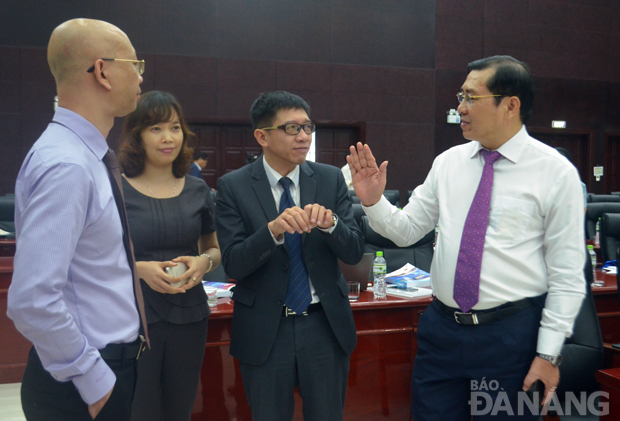Discussions about developing logistics in central region's key economic zone
A seminar took place in Da Nang on Wednesday to discuss ways to promote the development of the logistics sector in the central region’s key economic zone in the years ahead. Set up in 2008, the zone consists of Da Nang and the provinces of Thua Thien-Hue, Quang Nam, Quang Ngai and Binh Dinh.
 |
| Chairman Tho (first, right) talking with logistics experts at the seminar |
The Chairman of the Viet Nam Logistics Businesses’ Association, Mr Le Duy Hiep, noted that the key economic zone is now home to about 20 seaports. However, the total volume of cargo transported through these ports is lower than expected. For instance, the figure was 55.5 million tons in 2014, accounting for only 13% of the country’s total.
Chairman Hiep remarked that the main reasons are thought to be that the production output of many central region businesses is low, and many of the ports in the region are facing a severe shortage of anchorages for high-capacity ships, especially for container ships operating on long-distance maritime routes. Meanwhile, the Da Nang International Airport is not allowed by the Ministry of Industry and Trade to serve as a transit point for cargo entering Laos. Also, the central region, and the country as a whole, is in desperate need of human resources involved in the logistics sector. Currently, the Da Nang University of Economics is the only tertiary establishment in the central coast region with its own logistics faculty. Another reason is that the fees for loading and unloading cargo at the region’s ports are higher than those offered at ports in other regions of the country.
However, Da Nang has many distinct advantages for developing logistics services in the immediate future. The city is the Pacific gateway for the East-West Economic Corridor and it boasts improved traffic infrastructure systems, with convenient transportation via roads, railways, airways, waterways and seaports. The municipal government has already issued plans for developing the local logistics sector by 2020.
The focus is now on deploying the 2nd phase of the Tien Sa Port expansion project, constructing a new international terminal at the city’s airport, developing the Tien Sa Port into a special-use port for container and cruise ships, and constructing the multi-functional Lien Chieu Port. Furthermore, importance will also be attached to building a modern logistics area in Hoa Vang District’s Hoa Nhon Commune, and another one on the western side of the airport, plus other related facilities across the city.
The General Director of the Da Nang Port, Mr Nguyen Huu Sia, stressed the need to raise the cargo handling capacity of the port. Special attention will be paid to developing more warehouses and inland container depots at the Tien Sa Port in order to facilitate the transportation of cargo to recipient destinations in the city and to other localities in the key economic zone. Over the 2020 – 2025 period, the focus will be on expanding the system of warehouses for logistics services at the Lien Chieu Port.
Municipal People’s Committee Chairman Huynh Duc Tho remarked that the logistics sector plays an essential role in ensuring closer interconnection between production and business activities and services, as well as in promoting value-added supply chains and helping businesses enhance their competitiveness. He suggested that the localities’ authorities in the key economic zone should ensure the efficient use of their localities’ budget, along with loans and financial aid from domestic and foreign organisations, in order to develop logistic services.
Chairman Tho also proposed that the universities of Da Nang and Hue should make greater efforts to train human resources for the zone’s logistics sector, with a focus on enhancing the quality of lecturers in their logistics faculties, and cooperating with prestigious logistics training establishments worldwide in offering intensive courses for their students.